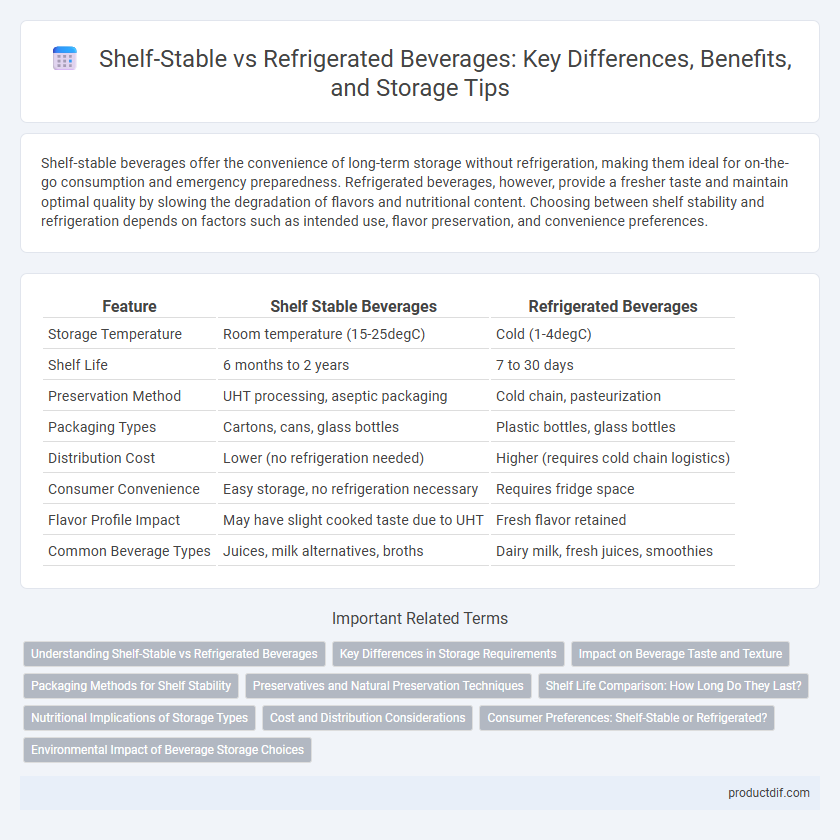Shelf-stable beverages offer the convenience of long-term storage without refrigeration, making them ideal for on-the-go consumption and emergency preparedness. Refrigerated beverages, however, provide a fresher taste and maintain optimal quality by slowing the degradation of flavors and nutritional content. Choosing between shelf stability and refrigeration depends on factors such as intended use, flavor preservation, and convenience preferences.
Table of Comparison
| Feature | Shelf Stable Beverages | Refrigerated Beverages |
|---|---|---|
| Storage Temperature | Room temperature (15-25degC) | Cold (1-4degC) |
| Shelf Life | 6 months to 2 years | 7 to 30 days |
| Preservation Method | UHT processing, aseptic packaging | Cold chain, pasteurization |
| Packaging Types | Cartons, cans, glass bottles | Plastic bottles, glass bottles |
| Distribution Cost | Lower (no refrigeration needed) | Higher (requires cold chain logistics) |
| Consumer Convenience | Easy storage, no refrigeration necessary | Requires fridge space |
| Flavor Profile Impact | May have slight cooked taste due to UHT | Fresh flavor retained |
| Common Beverage Types | Juices, milk alternatives, broths | Dairy milk, fresh juices, smoothies |
Understanding Shelf-Stable vs Refrigerated Beverages
Shelf-stable beverages undergo heat treatment and aseptic packaging to maintain quality and safety at room temperature for extended periods, eliminating the need for refrigeration. Refrigerated beverages rely on cold storage to prevent microbial growth and preserve freshness, often containing fewer preservatives than shelf-stable options. Understanding these differences is crucial for supply chain management, consumer convenience, and product formulation in the beverage industry.
Key Differences in Storage Requirements
Shelf-stable beverages are formulated with preservatives or undergo processes such as pasteurization to maintain quality at room temperature for extended periods, eliminating the need for refrigeration. Refrigerated beverages require consistent cold storage, typically below 40degF (4degC), to prevent microbial growth and preserve freshness. Understanding these storage requirements is essential for optimizing shelf life and ensuring product safety in supply chain management.
Impact on Beverage Taste and Texture
Shelf-stable beverages undergo pasteurization or UHT processing, which can slightly alter flavor by reducing fresh or raw taste notes, while refrigerated drinks retain more vibrant and complex flavor profiles due to minimal heat treatment. Texture differences are evident as shelf-stable beverages often have a more uniform and sometimes thinner mouthfeel, whereas refrigerated products maintain creaminess and carbonation integrity better. The choice between shelf stability and refrigeration significantly influences the sensory experience of beverages, affecting consumer perception and preference.
Packaging Methods for Shelf Stability
Shelf-stable beverages utilize advanced packaging methods such as aseptic processing, retort packaging, and high-barrier materials to extend product shelf life without refrigeration. These techniques prevent microbial growth and oxidation by sterilizing the contents and sealing them in oxygen-impermeable containers like Tetra Pak cartons or retort pouches. Compared to refrigerated packaging, shelf-stable methods reduce supply chain costs and increase product convenience while maintaining safety and taste integrity over months.
Preservatives and Natural Preservation Techniques
Shelf-stable beverages often rely on preservatives such as sorbates, benzoates, and sulfur dioxide to inhibit microbial growth and extend product lifespan without refrigeration. Natural preservation techniques like high-pressure processing, pasteurization, and the use of natural antioxidants from ingredients like rosemary extract and vitamin E enhance shelf stability while maintaining flavor and nutritional quality. Refrigerated beverages typically require fewer chemical preservatives, leveraging cold temperatures to slow microbial activity and preserve freshness.
Shelf Life Comparison: How Long Do They Last?
Shelf-stable beverages typically have a shelf life ranging from 6 months to 2 years due to airtight packaging and preservatives that inhibit microbial growth. Refrigerated beverages generally last from 7 to 21 days, depending on ingredients and storage conditions, as lower temperatures slow spoilage. Understanding this comparison helps consumers and retailers optimize inventory management and reduce waste.
Nutritional Implications of Storage Types
Shelf-stable beverages often undergo pasteurization or ultra-high temperature processing, which can reduce heat-sensitive nutrients like vitamin C and certain B vitamins. Refrigerated beverages typically retain higher levels of these nutrients due to minimal processing and cooler storage temperatures that slow nutrient degradation. Choosing between shelf-stable and refrigerated options impacts the nutritional profile, particularly the preservation of antioxidants and probiotics in functional drinks.
Cost and Distribution Considerations
Shelf-stable beverages reduce costs by eliminating the need for refrigerated transport and storage, enabling wider distribution networks and longer shelf life. Refrigerated beverages require continuous cold chain logistics, significantly increasing transportation and retail expenses. Choosing shelf stability enhances supply chain efficiency and lowers overall distribution costs, benefiting manufacturers and retailers.
Consumer Preferences: Shelf-Stable or Refrigerated?
Consumer preferences in the beverage industry often revolve around the convenience and taste attributes of shelf-stable versus refrigerated products. Shelf-stable beverages attract consumers seeking long-lasting storage without the need for refrigeration, especially in on-the-go or emergency scenarios, while refrigerated beverages are favored for freshness, flavor integrity, and perceived higher quality. Market analysis reveals a growing demand for shelf-stable options due to urban lifestyles and limited refrigeration access, although premium and natural beverage segments maintain a strong preference for chilled products.
Environmental Impact of Beverage Storage Choices
Shelf-stable beverages reduce carbon emissions by eliminating the need for continuous refrigeration, lowering energy consumption throughout the supply chain. Refrigerated beverages require constant cooling, increasing electricity use and contributing to higher greenhouse gas emissions. Choosing shelf-stable options supports sustainable practices by minimizing environmental impact associated with beverage storage and transportation.
Shelf Stability vs Refrigerated Infographic

 productdif.com
productdif.com